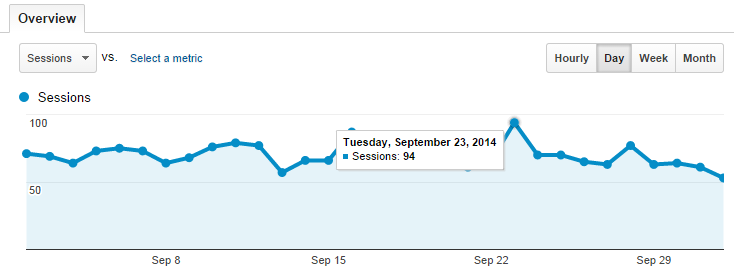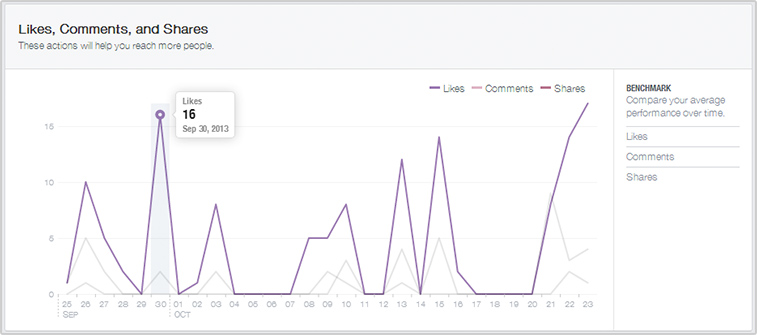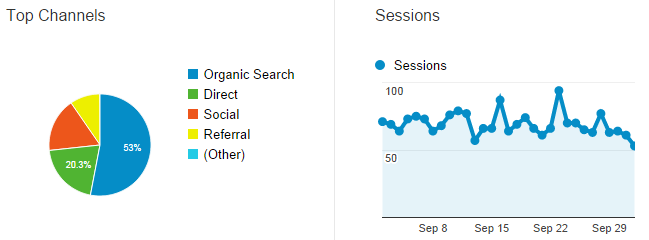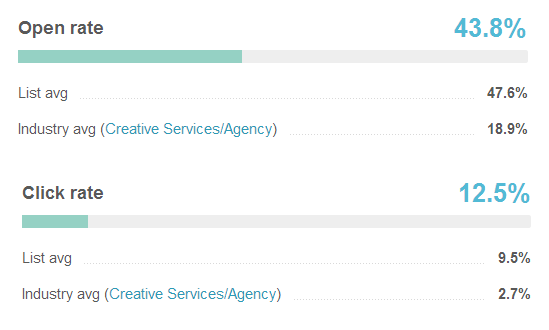One of the most significant advantages of online marketing is that it’s relatively easy to obtain data and accurately track the performance of your marketing strategy.
However, to make sense of the vast amount of data generated by your various online marketing outlets, you’ll need to use an analytics tool such as Google Analytics.
[Tweet “Measuring your online marketing performance is vital in order to improve your strategy”]Tracking the performance of every area of your online marketing strategy is crucial to success, since it will provide invaluable insights into your target audience while also exposing the under-performing areas of your strategy.
By tracking certain key performance indicators (KPIs) right from the outset, you’ll be able to keep your online marketing efforts moving forward by focussing your resources where they are most effective.
In this article, we’ll take a look at some of the most important KPIs to track across all areas of your online marketing campaign including content, social, search and email.
Tracking Website Traffic
Online marketing revolves around content, and all of your efforts will typically start at your website, even if your site consists of nothing more than a simple landing page.
The purpose of your website is to turn as many of your visitors as possible into sales or leads, and you’ll need to pay close attention to the following dimensions to determine how efficiently your website is fulfilling its goals:
Daily Visitors
The most important statistic to track is the average number of daily visitors to your website, as well as the growth of this figure. Obviously, one of your primary goals will be to increase this figure as much as possible, but be sure not to overestimate the importance of numbers alone.
Traffic is undoubtedly one of your key metrics, but remember that it’s better to have 100 hits of which 25% end up in sales than 1000 hits of which 1% result in sales. Don’t get too caught up in the big figures.
 Daily Visitors – Google Analytics
Daily Visitors – Google Analytics
Bounce Rate
Your bounce rate refers to the percentage of visitors who view only a single page on your website and leave.
This statistic will help to indicate the quality of the traffic coming to your website and the effectiveness of your landing pages, making it just as important to track as the number of visitors itself.
New vs Returning Visitors
In order to become successful, you’ll need to have a healthy amount of regular visitors while still attracting new visitors on a regular basis. Ideally, your repeat visitor percentage should be around 20-30%.
Referral Traffic
Knowing where your visitors are coming from, whether from the search engine results page, social media posts, referrals or paid online advertisements, is absolutely crucial for determining which areas of your online marketing campaign are keeping your business moving forward and which ones are holding it back.
Page Views / Average Time on Page
You should also track which pages or articles on your website are most popular as well as how much time your visitors tend to spend on them. Distinguishing your most popular content will help you to find out what makes your audience tick.
 Metrics for new and returning visitors – Google Analytics
Metrics for new and returning visitors – Google Analytics
Conversion Rate
The conversion rate is another essential statistic to track. After all, you could have an enormous amount of traffic and a wonderfully low bounce rate, but it’s all for nought if your conversion rate isn’t increasing as well.
There are two key conversion rates to track. Goal conversion; which is a predetermined goal you have set for your visitors, such as downloading a file or subscribing to a newsletter. If you sell via your website, you’ll be more concerned with your ecommerce conversion rate.
Always make sure you know the percentage of visitors who become leads or customers. Find out more about conversion rates here.
Tracking Social Media Marketing Performance
Many successful online marketers say that social media marketing is the new search engine marketing, and there certainly is an element of truth in that.
Social media platforms are built around the concept of engagement and two-way conversation, offering the potential to drive traffic to your website by delivering value, engaging in conversation and sharing content. Following are some of the key social metrics to track:
Engagement (likes, shares, comments, retweets, +1s)
Track the rate of engagement for each social network you use, such as the number of people sharing your content, retweeting your Twitter posts or liking your Facebook posts.
Likewise, be sure to track the number of comments and get involved in the conversation yourself.
Some social platforms offer their own tools to allow you to access and analyse this data easily, with Facebook Insights and Twitter Analytics being two of the best.
 Likes, comments. and shares – Facebook Insights
Likes, comments. and shares – Facebook Insights
Follower / Fan Numbers
The number of followers or fans which your social networking profiles attract is another important engagement metric to track. You’ll be looking for a constant and steady increase in the numbers here, while a sudden drop in numbers might mean you should re-evaluate your posting strategy.
Brand Mentions
Track the number of mentions of your company on social media and find out what people are saying about it. Rather than just tracking the numbers alone, you’ll also want to keep involved in the conversation in order to get a better idea of what people actually think about your company.
There are several tools online that can help with tracking brand mentions online, such as aptly named “Social Mention” or the app-based “Mention“.
 Social Mention
Social Mention
Determine which of your social media profiles are delivering the most impressive results by tracking the amount of traffic coming to your website from each one, as well as the conversion rates for said traffic. You can use the Social filter on Google Analytics for a more in-depth overview.
Tracking Search Engine Performance
Although social media is extremely important, search engine marketing still plays a major role. After all, most of the world’s Web traffic is driven by Google and other search engines, and the search engine results page (SERPs) is likely where most of your first-time visitors will be coming from, regardless of the performance of your social media marketing strategy.
Organic Traffic
Determine the total number of first-time visitors coming from a link in the SERPs. Generally, around half of your traffic will be coming from organic searches rather than sponsored links in the search results from Google AdWords.
 Referral Channels – Google Analytics
Referral Channels – Google Analytics
Keyword Tracking
You’ll also need to track the performance of the keywords you are targeting by determining which keywords people are entering in order to find your website. In some cases, you may find that it’s necessary to modify your keyword strategy.
Check out our guide to short-tail and long-tail keywords, and optimise for the best search terms for your niche.
Visits via Branded Search Terms
The number of visitors which reach your website using branded keywords in the search engines, such as the name of your business or one of your products or services, can provide an invaluable insight into the reach of your company.
Backlink Profile
Your backlink profile, the total number and location of backlinks to your website, can tell a great deal about your search engine ranking and exposure.
Link building is an essential part of SEO, but links on poor quality article directories, links that have been paid for and links on irrelevant websites should be removed quickly, otherwise, your website may end up being penalised by the search engines.
Tracking Email Marketing Performance
Email marketing is definitely not dead, contrary to what some marketers may have you believe.
In spite of the precedence of social media, email remains the most popular method for keeping in contact, particularly in business-to-business (B2B) industries. Potentially providing the highest return on investment, email marketing also offers a wealth of useful metrics to track.
Open Rate
In addition to tracking the click-through and conversion rates of your email newsletters, you will need to track email-specific metrics such as open rates.
A higher open rate tends to point to more effective subject lines and engaging topics.
 Open Rates – Mailchimp
Open Rates – Mailchimp
Unsubscribe Rate
There will always be people who will unsubscribe from your newsletters, but according to the email marketing service MailChimp, the unsubscribe rate should ideally stay below one percent.
Higher unsubscribe rates often point to a poorly kept mailing list consisting of too many irrelevant contacts.
Bounce Rate
The bounce rate, in terms of email marketing, refers to the number of undelivered emails. While a good email marketing service provider should remove invalid email addresses, it is still important to track your bounce rate in order to keep tabs on the quality of your mailing list.
Check out our Top 10 Email Marketing Tips post for more tips on how to improve your campaigns.
Conclusion
Tracking the performance of your online marketing efforts need not be difficult nor particularly time-consuming, thanks to a large number of both free and paid tools available to help you.
One of the most comprehensive among the free analytics tools being Google Analytics, allowing you to create custom reports, alerts, dashboards and more.
Additionally, the social networks you use for marketing your business will also be able to provide you with a wealth of useful statistics which will help you to keep your business moving forward.
Your Say!
How do you measure your online marketing success? What are the key metrics you look out for when creating reports? Let us know in the comments below.

One thought on “How to Measure Online Marketing Performance”
Comments are closed.